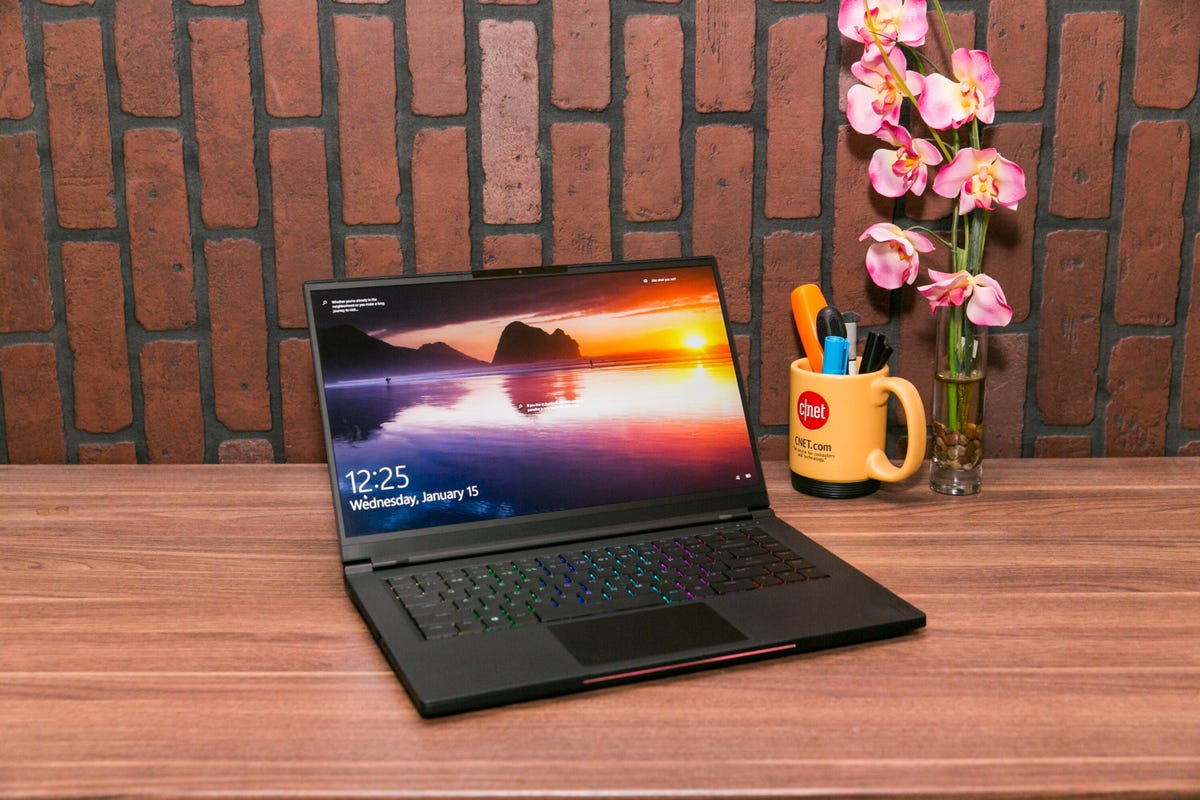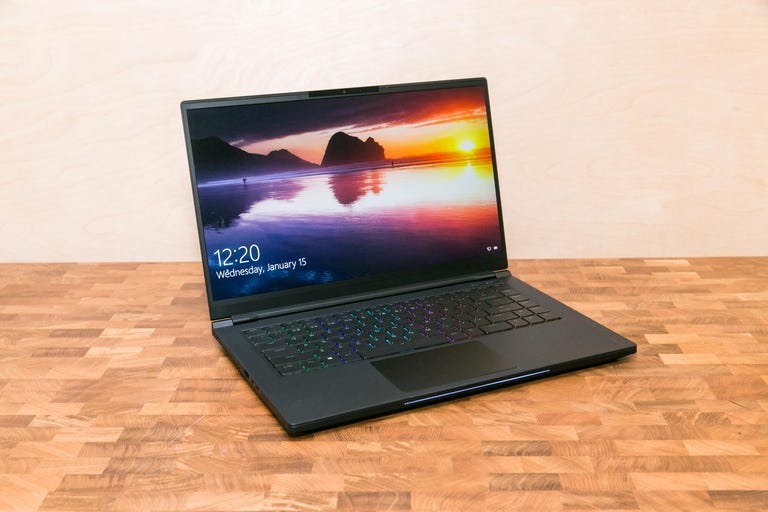 Why You Can Trust CNET
Why You Can Trust CNET A great gaming laptop you've probably never considered
Just off the beaten path you'll find this stylish, well-designed and relatively light gaming notebook with solid performance.

Maingear's not a household name for laptop buyers; it's better known for its custom-built desktops and comfy gaming chairs. And like other custom builders such as Origin PC, it traditionally uses some third-party chassis for its limited line of laptops. The Maingear Element 15-inch gaming laptop is the company's first individualized design -- though not exclusive -- which emerged via a collaboration with Intel . The result is a stylish and relatively light notebook with solid gaming performance that I happen to like quite a bit.
Like
- Smart and stylish design
- Relatively light
- Comparatively well priced
Don't like
- Maingear Node utility is bare-bones and somewhat confusing
You won't be overwhelmed by configuration choices for the Element: It starts at $1,699 with an Nvidia GeForce 1660 Ti, 16GB RAM and 1TB SSD, the same with an RTX 2070 Max-Q is $2,099 and a 2070 model with 32GB RAM and a 2TB SSD is $2,299. You can also get a gunmetal-color chassis with the top configuration for an extra $100. Also, I tested a limited-edition version that included a custom Pelican travel case.
Unless you plan to connect to an external monitor to play at 1440p or want to set quality at superduper, the 1660 Ti base model should be fine for most games. Regardless of configuration, you'll get the same unremarkable, narrow-color-gamut 144Hz 1080p 15.6-inch screen found on a multitude of gaming laptops.
Maingear ships overseas, but doesn't set international prices. That means you configure it and don't know how much it will be in local currency until you're well into the checkout process. The price ranges at today's exchange rates are roughly £1,300 to £1,840 and AU$2,470 to AU$3,490.
Performance is right in line with what you'd expect from the set of components. While the battery life tested at a miserable 2.2 hours, it also performed better than others on benchmarks. That can signal that the system's defaults are optimized slightly differently. In practice, the battery lasted notably longer than that when we used it for typical lightweight work tasks.
Maingear Element
| Price as reviewed | $2,299 |
|---|---|
| Display | 15.6-inch 1,920x1,080 144Hz |
| PC CPU | 2.6GHz Intel Core i7-9750H |
| PC memory | 32GB 2,666Hz DDR4 |
| Graphics | Nvidia GeForce RTX 2070 Max-Q |
| Storage | 2TB SSD, SD card reader |
| Ports | 1 x USB-C/Thunderbolt, 3 x USB-A, 1 x HDMI, headphone, mic |
| Networking | Intel Wi-Fi 6 AX200, Bluetooth 5.0 |
| Operating system | Microsoft Windows 10 Pro (1903) |
| Weight | 4.1 lbs/1.9 kg |
In pricing the Element is pretty comparable to similar models, such as the MSI GS65 Stealth, though less than more high-profile competitors like the Alienware m15 R2 or Razer Blade Advanced with the same components. However, the even less well-known Eluktronics uses the same chassis for its MAG-15, and its equivalent configuration runs $200 less (£150 and AU$290). Note that they may differ in some important ways, such as thermal ceilings and cooling system, which can impact performance. Their batteries are the same 94Wh capacity, though.
All the sleekifying elements we've come to expect are here: narrow screen bezels, thinnish 0.8-inch (19mm) thickness, matte-textured magnesium-alloy body, glass touchpad, a snazzy underglow light bar at the front and so on. There's a dedicated button for cycling among power modes, mainly to control cooling. You don't want those fans blasting during meetings -- even Chrome can set them a-blowin' -- and headphones are highly recommended for gaming. In fact, headphones are recommended for a lot of things; the speakers can get surprisingly loud for a laptop, but they also sound a bit echoey.
There are separate mic and headphone jacks rather than a combo, which can be useful for some people, as well as a basic 720p webcam, IR camera for Windows Hello login and an SD card slot -- features that tend to be omitted from gaming laptops. The power, USB-C, Ethernet and HDMI connections are all on the back, which means the AC connector won't start fights with your wired controller, keyboard and mouse.
Some people may consider the optomechanical keyboard an acquired taste, though I quite like its tactile, quietly clicky feel and solid 2mm travel. Plus, of course, there's the per-key RGB lighting, which you can customize using the basic Maingear Node control center utility -- or try, because the interface is somewhat confusing.
The utility is pretty elementary with a system monitor, power and fan presets, light bar and keyboard brightness and color settings and display presets, which change brightness, and, for the Reading preset, the white point (you can also adjust the individual RGB values). It also lets you lock the Windows key and display function keys onscreen.
But while custom builders tend to lack sophisticated control centers, you've gotta love the no-bloatware policy many of them have, including Maingear. The Element's not as pristine as some I've seen, but it's not infested with third-party stuff like anti-virus software and Microsoft Office trials. What software is there is tucked away in Start menu tile groups where you don't have to see it.
Geekbench 4 (multicore)
Cinebench R15 CPU (multicore)
Video playback battery drain test (streaming, minutes)
3DMark Fire Strike Ultra
3DMark Port Royal (RTX)
System configurations
| Alienware m15 R2 | Microsoft Windows 10 Home (64-bit); 2.6GHz Intel Core i7-9750H; 16GB DDR4 SDRAM 2,666MHz; 8GB Nvidia GeForce RTX 2080 with Max-Q Design; 1TB SSD RAID 0 |
|---|---|
| Gigabyte Aero 15 OLED XA | Microsoft Windows 10 Pro (64-bit); 2.6GHz Intel Core i7-9750H; 16GB DDR4 SDRAM 2,666MHz; 8GB Nvidia GeForce RTX 2070 with Max-Q Design; 512GB SSD |
| HP Omen X 2S | Microsoft Windows 10 Home (64-bit); 2.6GHz Intel Core i7-9750H; 16GB DDR4 SDRAM 2,666MHz; 8GB Nvidia GeForce GTX 2080 with Max-Q Design; 1TB SSD |
| Lenovo Legion Y545 | Microsoft Windows 10 Home (64-bit); 2.6GHz Intel Core i7-9750H; 16GB DDR4 SDRAM 2,667MHz; 6GB Nvidia GeFroce GTX 1660Ti; 128GB SSD + 1TB HDD |
| Maingear Element | Microsoft WIndows 10 Pro (1903); 2.6GHz Intel Core i7-9750H; 32GB DDR4 SDRAM 2,667MHz, 8GB Nvidia GeForce RTX 2070 with Max-Q Design, 2TB SSD |
| Razer Blade Advanced (2019, OLED) | Microsoft Windows 10 Home (64-bit); 2.6GHz Intel Core i7-9750H; 16GB DDR4 SDRAM 2,666MHz; 8GB Nvidia GeForce RTX 2080 with Max-Q Design; 512GB SSD |


